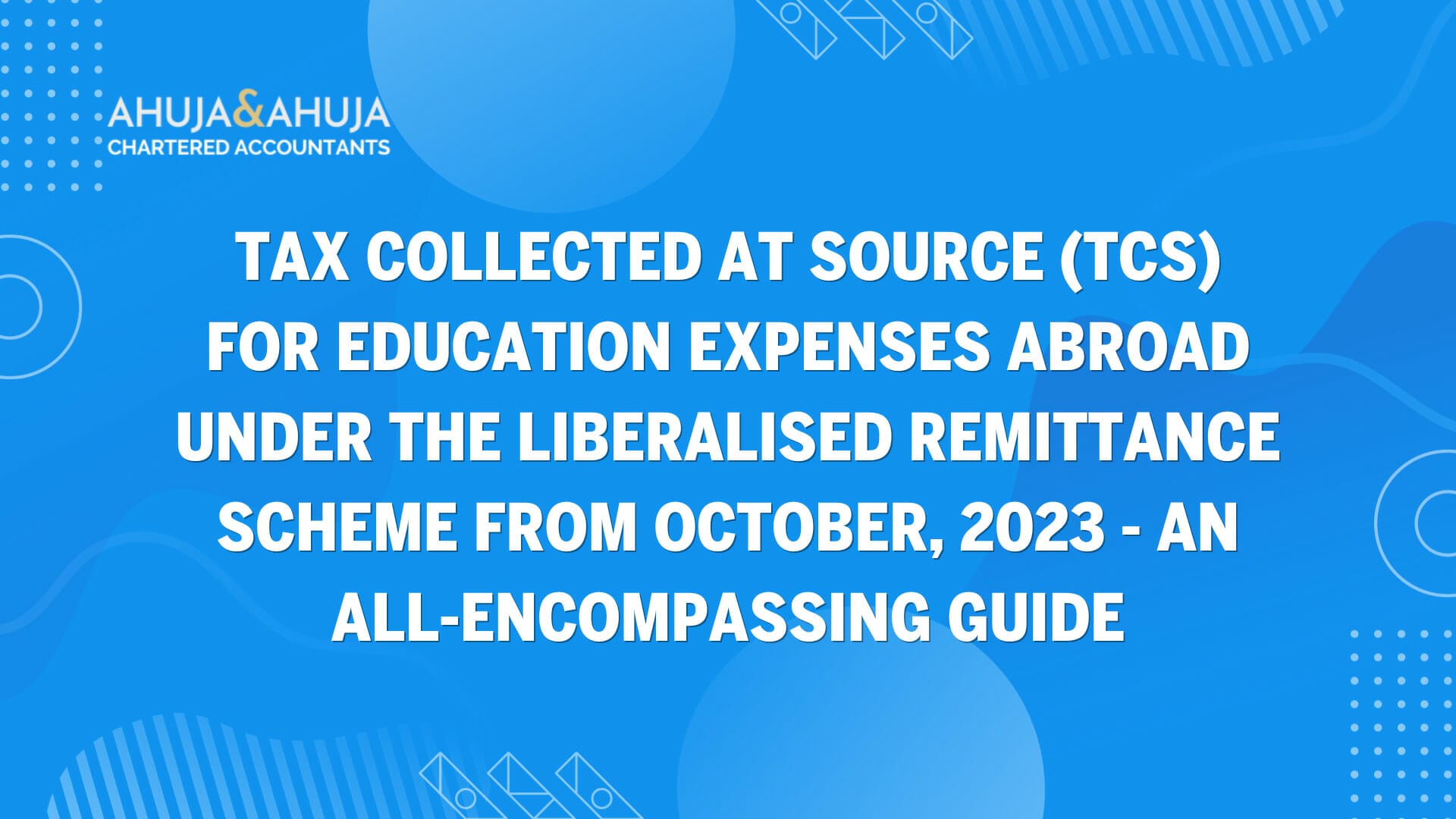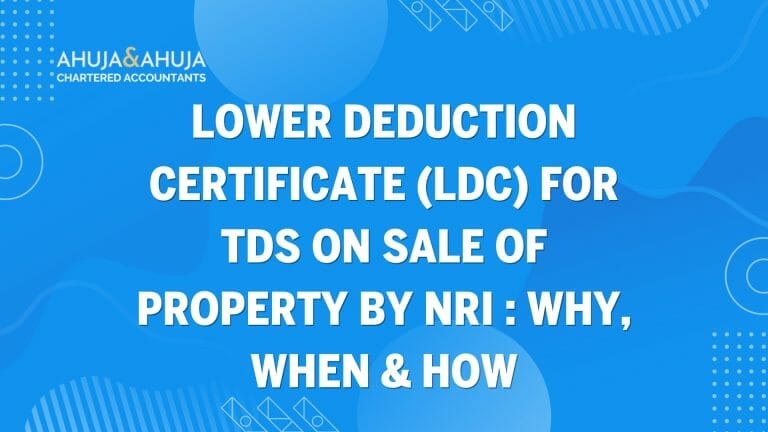Tax Collected at Source (TCS) for Education Expenses Abroad under Liberalised Remittance Scheme from October, 2023
In today’s world where globalization has extended its reach into nearly every sector, acquiring education abroad is a growing trend. Many passionate Indian students aspire to advance their learning in foreign universities to receive global exposure. However, the shift from domestic to international expenses brings with it the complexity of taxation.
Understandably, this sudden dive into the profound sea of taxes and remittances might seem a tad bit overwhelming to many. With the intention to simplify this seemingly complicated scenario, we present this detailed guide on TCS (Tax Collected at Source) levied on education expenses for studying abroad under the Liberalised Remittance Scheme (LRS), effective from October, 2023.
Introduction
Let’s begin with the fundamentals – What is Tax Collected at Source (TCS)? Essentially, TCS is a form of tax that sellers collect at the point of sale. The sellers then deposit this tax to the government. A TCS certificate is issued by the seller to the buyer, indicating the amount of tax collected.
Why is this relevant to you, an aspiring overseas student? When you remit large sums of money overseas for your education, TCS is applied as per the Income Tax Act of India. The weight of understanding these taxes might seem burdensome, especially when you have numerous other preparations to take care of. However, with a seasoned tax consultant at your side such as Ahuja and Ahuja, this process becomes significantly simplified.
Now that we broadly understand TCS, our next focal point is the connection between your foreign education and the Liberalised Remittance scheme.
I’ll continue with the next part, focusing on understanding the Liberalised Remittance Scheme (LRS), in our next segment. Kindly confirm your agreement with this approach.
Understanding the Liberalised Remittance Scheme (LRS)
To create a solid foundation of knowledge, it is essential to comprehend the workings of the Liberalised Remittance Scheme (LRS). The LRS is a system that permits individuals in India to remit funds for various purposes, including education expenses for studying abroad.
Under the LRS, individuals can remit up to $2,50,000 for a range of purposes. These purposes include private visits to any country (except Nepal and Bhutan), gifting or donating, going abroad for employment, emigration, maintenance of close relatives abroad, travel for business, attending conferences or specialized training, meeting medical expenses or check-ups abroad, expenses in connection with medical treatment abroad, studies abroad, and any other current account transaction.
In short, the LRS provides a platform for individuals to seamlessly transfer funds abroad for multiple legitimate reasons. This scheme has made it easier for Indian students to pursue their dreams of studying abroad.
If you require expert guidance in navigating international taxation matters, including the LRS and its implications, Ahuja and Ahuja is here to assist you. Their expertise in international taxation and assistance with obtaining important documents such as tax residency certificates (TRC) will prove invaluable.
Moving forward, let’s explore the connection between the Liberalised Remittance Scheme (LRS) and Tax Collected at Source (TCS) under the Income-Tax Act.
Next, I will delve into the connection between the LRS and TCS. Please confirm if you’re ready to proceed.
Connection between the Liberalised Remittance Scheme (LRS) and Tax Collected at Source (TCS)
Under the provisions of the Income-tax Act, 1961, the collection of TCS is mandated on two types of transactions: foreign remittance through the Liberalised Remittance Scheme (LRS), and the sale of overseas tour program packages. In our context, we are concerned with the TCS applicable to foreign remittance for education expenses under the LRS.
To put it simply, when you remit funds under the LRS for education purposes, TCS is collected by the bank or authorized dealer at the time of the transaction. The collected tax is then deposited with the government. This collection mechanism is in place to ensure compliance with income tax regulations and to streamline the process of tax collection for such transactions.
TCS is an important aspect to consider when planning your finances for education abroad. It is advisable to consult with professionals, such as Ahuja and Ahuja, who specialize in international taxation matters, including TCS compliance. Their expertise and guidance will ensure that you have a firm grasp of the regulations and can navigate the process smoothly.
In the next section, we will delve into the specific details of what constitutes educational purposes under the LRS. Understanding this will help you navigate the intricacies of remittances for education expenses abroad.
Defining Educational Purposes under the Liberalised Remittance Scheme (LRS)
Now that we have established the connection between the LRS and TCS, let’s dive into what exactly constitutes educational purposes under the LRS.
When you plan to study abroad, various components of your education expenses fall under the purview of the LRS. These include:
- Remittance for purchase of tickets: This covers the cost of airfare or transportation for the person undertaking the study abroad, facilitating travel between India and the overseas educational institution.
- Tuition and other fees: The LRS encompasses remittances made for paying tuition fees and other associated charges to the educational institute where you have taken admission.
- Ancillary expenses: Apart from the direct educational costs mentioned above, the LRS also covers other expenses necessary for undertaking your education abroad. These may include day-to-day living expenses, accommodation costs, food expenses, transportation costs within the foreign country, and other similar ancillary expenses.
By understanding the different components covered under the LRS for educational purposes, you can better plan your finances and ensure compliance with the regulations. Ahuja and Ahuja, with their expertise in international taxation, can guide you through the intricacies of these remittances and help you make informed financial decisions.
In the next section, we will discuss the specific tax rates applicable to education expenses remitted abroad under the LRS from October, 2023. Stay tuned for more information on this vital aspect.
Taxation Applicable for Educational Remittances
Now that we have a clear understanding of the educational purposes covered under the LRS, let’s delve into the taxation aspect of these remittances. It’s important to note that the tax rates for education expenses under the LRS vary depending on whether the education is financed by a loan or not.
Education Financed by Loan
For education expenses abroad that are financed by a loan, the following TCS rates apply:
- Up to INR 7 lakhs: No TCS is applicable.
- Beyond INR 7 lakhs: TCS is levied at a rate of 0.5%.
Education Not Financed by Loan
For education expenses abroad that are not financed by a loan, the following TCS rates apply:
- Up to INR 7 lakhs: No TCS is applicable.
- Beyond INR 7 lakhs: TCS is levied at a rate of 5%.
It’s important to note that these rates are applicable from October, 2023. It’s advisable to consult with tax professionals, such as Ahuja and Ahuja, who specialize in international taxation matters, to ensure compliance with updated regulations.
Understanding the tax rates applicable to your education expenses will help you plan your finances accordingly. Ahuja and Ahuja can provide expert advice tailored to your specific situation, ensuring that you meet all tax obligations while minimizing any tax burden.
In the next section, we will provide comprehensive details about the TCS rates for education expenses abroad post-October, 2023. Stay tuned for a deeper understanding of the specific rates and their implications.
TCS Rates for Education Expenses Abroad post-October, 2023
To ensure that you stay informed about the tax implications of your education expenses abroad, let’s delve into the specific TCS rates applicable from October, 2023.
The TCS rates for education expenses under the Liberalised Remittance Scheme (LRS) remain unchanged after October, 2023. As mentioned earlier, for education financed by a loan, there is no TCS applicable for remittances up to INR 7 lakhs. Beyond INR 7 lakhs, a TCS rate of 0.5% is applicable.
Similarly, for education not financed by a loan, there is no TCS applicable for remittances up to INR 7 lakhs. Beyond INR 7 lakhs, a TCS rate of 5% is applicable.
It is essential to keep these rates in mind when planning your finances for studying abroad. Ahuja and Ahuja, with their expertise in international taxation matters, can help you navigate the complexities of TCS compliance and provide personalized guidance to ensure that you meet all tax obligations.
Stay updated with the latest regulations and consult with professionals like Ahuja and Ahuja for accurate and up-to-date information regarding TCS rates and any changes that may occur in the future.
In the next section, we will address frequently asked questions (FAQs) related to the Liberalised Remittance Scheme (LRS) and Tax Collected at Source (TCS) for education expenses abroad. These FAQs will provide further clarity on common queries you may have.
FAQs
Here are some frequently asked questions (FAQs) related to the Liberalised Remittance Scheme (LRS) and Tax Collected at Source (TCS) for education expenses abroad:
How does the Liberalised Remittance Scheme (LRS) benefit Indian students planning to study abroad?
The LRS allows individuals in India to remit funds up to $2,50,000 per year for various purposes, including education expenses. This scheme provides a convenient and regulated way to transfer funds abroad for education purposes, making it easier for Indian students to pursue their dreams of studying abroad.
What is the significance of Tax Collected at Source (TCS) for education expenses under the LRS?
TCS is a form of tax collected by banks or authorized dealers at the time of foreign remittance. For education expenses under the LRS, TCS is applicable to ensure compliance with income tax regulations and streamline the process of tax collection.
Are there different tax rates for education expenses financed by a loan and those not financed by a loan?
Yes, different TCS rates apply based on whether the education expenses are financed by a loan or not. For education financed by a loan, TCS rates of 0.5% apply for remittances beyond INR 7 lakhs. For education not financed by a loan, TCS rates of 5% apply for remittances beyond INR 7 lakhs.
Can I seek professional assistance to navigate international taxation matters related to education expenses under the LRS?
Absolutely! Seeking professional assistance from experts like Ahuja and Ahuja can help you understand and comply with the taxation regulations pertaining to education expenses abroad. They have extensive experience in international taxation and can guide you through the process.
If you have any more questions or concerns regarding the Liberalised Remittance Scheme (LRS), Tax Collected at Source (TCS), or any other related matters, feel free to consult with professionals like Ahuja and Ahuja. They can provide personalized advice based on your specific situation.
Remember, staying informed and seeking expert guidance is key to effectively managing your finances while studying abroad.
Disclaimer
The materials provided herein are solely for educational and informational purposes. No attorney/professional-client relationship is created when you access or use the site or the materials. The information presented on this site does not constitute legal or professional advice and should not be relied upon for such purposes or used as a substitute for professional or legal advice.




